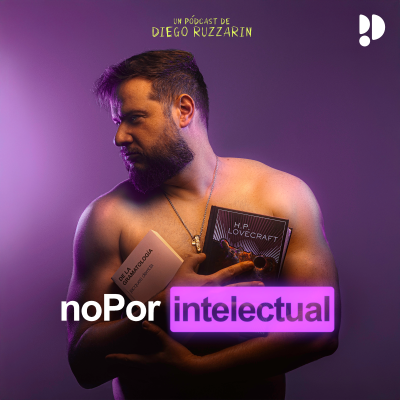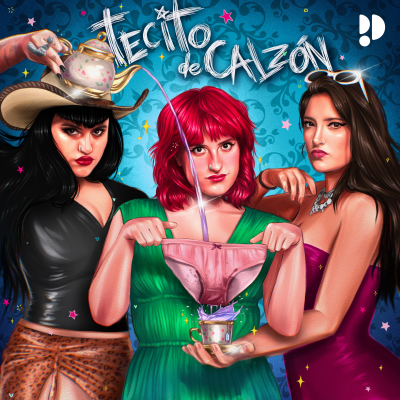
Machine Learning Guide
inglés
Tecnología y ciencia
Empieza 7 días de prueba
$99 / mes después de la prueba.Cancela cuando quieras.
- 20 horas de audiolibros al mes
- Podcasts solo en Podimo
- Podcast gratuitos
Acerca de Machine Learning Guide
Machine learning audio course, teaching the fundamentals of machine learning and artificial intelligence. It covers intuition, models (shallow and deep), math, languages, frameworks, etc. Where your other ML resources provide the trees, I provide the forest. Consider MLG your syllabus, with highly-curated resources for each episode's details at ocdevel.com. Audio is a great supplement during exercise, commute, chores, etc.
Todos los episodios
64 episodiosMLA 027 AI Video End-to-End Workflow
How to maintain character consistency, style consistency, etc in an AI video. Prosumers can use Google Veo 3's "High-Quality Chaining" for fast social media content. Indie filmmakers can achieve narrative consistency by combining Midjourney V7 for style, Kling for lip-synced dialogue, and Runway Gen-4 for camera control, while professional studios gain full control with a layered ComfyUI pipeline to output multi-layer EXR files for standard VFX compositing. Links * Notes and resources at ocdevel.com/mlg/mla-27 [https://ocdevel.com/mlg/mla-27?utm_source=podcast&utm_medium=mlg&utm_campaign=mla27] * Try a walking desk [https://ocdevel.com/walk?utm_source=podcast&utm_medium=mlg&utm_campaign=mla27] - stay healthy & sharp while you learn & code * Descript [https://ocdevel.com/creator] - my favorite AI audio/video editor AI Audio Tool Selection * Music: Use Suno [https://www.topmediai.com/ai-music/suno-vs-udio/] for complete songs or Udio [https://www.reddit.com/r/SunoAI/comments/1ho7n2v/suno_or_udio/] for high-quality components for professional editing. * Sound Effects: Use ElevenLabs' SFX [https://elevenlabs.io/blog/best-ai-sound-effect-generators-2024] for integrated podcast production or SFX Engine [https://sfxengine.com/solutions/game-developers] for large, licensed asset libraries for games and film. * Voice: ElevenLabs [https://www.aiautomationspot.com/post/elevenlabs-ai-voice-generator] gives the most realistic voice output. Murf.ai [https://foundationinc.co/lab/elevenlabs-vs-murf-ai/] offers an all-in-one studio for marketing, and Play.ht [https://play.ht/blog/ai-apps/vs/playht-vs-elevenlabs/] has a low-latency API for developers. * Open-Source TTS: For local use, StyleTTS 2 [https://styletts2.github.io/] generates human-level speech, Coqui's XTTS-v2 [https://autogpt.net/best-ai-sound-effect-generators/] is best for voice cloning from minimal input, and Piper TTS [https://github.com/rhasspy/piper] is a fast, CPU-friendly option. I. Prosumer Workflow: Viral Video Goal: Rapidly produce branded, short-form video for social media. This method bypasses Veo 3's weaker native "Extend" feature. * Toolchain * Image Concept: GPT-4o (API: GPT-Image-1) for its strong prompt adherence, text rendering, and conversational refinement. * Video Generation: Google Veo 3 for high single-shot quality and integrated ambient audio. * Soundtrack: Udio for creating unique, "viral-style" music. * Assembly: CapCut for its standard short-form editing features. * Workflow 1. Create Character Sheet (GPT-4o): Generate a primary character image with a detailed "locking" prompt, then use conversational follow-ups to create variations (poses, expressions) for visual consistency. 2. Generate Video (Veo 3): Use "High-Quality Chaining." * Clip 1: Generate an 8s clip from a character sheet image. * Extract Final Frame: Save the last frame of Clip 1. * Clip 2: Use the extracted frame as the image input for the next clip, using a "this then that" prompt to continue the action. Repeat as needed. 3. Create Music (Udio): Use Manual Mode with structured prompts ([Genre: ...], [Mood: ...]) to generate and extend a music track. 4. Final Edit (CapCut): Assemble clips, layer the Udio track over Veo's ambient audio, add text, and use "Auto Captions." Export in 9:16. II. Indie Filmmaker Workflow: Narrative Shorts Goal: Create cinematic short films with consistent characters and storytelling focus, using a hybrid of specialized tools. * Toolchain * Visual Foundation: Midjourney V7 to establish character and style with --cref and --sref parameters. * Dialogue Scenes: Kling for its superior lip-sync and character realism. * B-Roll/Action: Runway Gen-4 for its Director Mode camera controls and Multi-Motion Brush. * Voice Generation: ElevenLabs for emotive, high-fidelity voices. * Edit & Color: DaVinci Resolve for its integrated edit, color, and VFX suite and favorable cost model. * Workflow 1. Create Visual Foundation (Midjourney V7): Generate a "hero" character image. Use its URL with --cref --cw 100 to create consistent character poses and with --sref to replicate the visual style in other shots. Assemble a reference set. 2. Create Dialogue Scenes (ElevenLabs -> Kling): * Generate the dialogue track in ElevenLabs and download the audio. * In Kling, generate a video of the character from a reference image with their mouth closed. * Use Kling's "Lip Sync" feature to apply the ElevenLabs audio to the neutral video for a perfect match. 3. Create B-Roll (Runway Gen-4): Use reference images from Midjourney. Apply precise camera moves with Director Mode or add localized, layered motion to static scenes with the Multi-Motion Brush. 4. Assemble & Grade (DaVinci Resolve): Edit clips and audio on the Edit page. On the Color page, use node-based tools to match shots from Kling and Runway, then apply a final creative look. III. Professional Studio Workflow: Full Control Goal: Achieve absolute pixel-level control, actor likeness, and integration into standard VFX pipelines using an open-source, modular approach. * Toolchain * Core Engine: ComfyUI with Stable Diffusion models (e.g., SD3, FLUX). * VFX Compositing: DaVinci Resolve (Fusion page) for node-based, multi-layer EXR compositing. * Control Stack & Workflow 1. Train Character LoRA: Train a custom LoRA on a 15-30 image dataset of the actor in ComfyUI to ensure true likeness. 2. Build ComfyUI Node Graph: Construct a generation pipeline in this order: * Loaders: Load base model, custom character LoRA, and text prompts (with LoRA trigger word). * ControlNet Stack: Chain multiple ControlNets to define structure (e.g., OpenPose for skeleton, Depth map for 3D layout). * IPAdapter-FaceID: Use the Plus v2 model as a final reinforcement layer to lock facial identity before animation. * AnimateDiff: Apply deterministic camera motion using Motion LoRAs (e.g., v2_lora_PanLeft.ckpt). * KSampler -> VAE Decode: Generate the image sequence. 3. Export Multi-Layer EXR: Use a node like mrv2SaveEXRImage to save the output as an EXR sequence (.exr). Configure for a professional pipeline: 32-bit float, linear color space, and PIZ/ZIP lossless compression. This preserves render passes (diffuse, specular, mattes) in a single file. 4. Composite in Fusion: In DaVinci Resolve, import the EXR sequence. Use Fusion's node graph to access individual layers, allowing separate adjustments to elements like color, highlights, and masks before integrating the AI asset into a final shot with a background plate.
MLA 026 AI Video Generation: Veo 3 vs Sora, Kling, Runway, Stable Video Diffusion
Google Veo leads the generative video market with superior 4K photorealism and integrated audio, an advantage derived from its YouTube training data. OpenAI Sora is the top tool for narrative storytelling, while Kuaishou Kling excels at animating static images with realistic, high-speed motion. Links * Notes and resources at ocdevel.com/mlg/mla-26 [https://ocdevel.com/mlg/mla-26?utm_source=podcast&utm_medium=mlg&utm_campaign=mla26] * Try a walking desk [https://ocdevel.com/walk?utm_source=podcast&utm_medium=mlg&utm_campaign=mla26] - stay healthy & sharp while you learn & code * Build the future of multi-agent software with AGNTCY [https://agntcy.org/?__hstc=105720540.0a8b762106a9ca77d03425faf542e3bd.1742839154237.1745445081089.1745506887590.70&__hssc=105720540.11.1745506887590&__hsfp=3347877758]. S-Tier: Google Veo The market leader due to superior visual quality, physics simulation, 4K resolution, and integrated audio generation [https://em360tech.com/tech-articles/what-google-veo-inside-ai-video-generator], which removes post-production steps. It accurately interprets cinematic prompts ("timelapse," "aerial shots"). Its primary advantage is its integration with Google products, using YouTube's vast video library for rapid model improvement. The professional focus is clear with its filmmaking tool, "Flow." [https://futurefive.co.nz/story/google-launches-flow-ai-tool-for-filmmakers-and-video-creators] A-Tier: Sora & Kling * OpenAI Sora: Excels at interpreting complex narrative prompts and has wide distribution through ChatGPT. Features include in-video editing tools like "Remix" and a "Storyboard" function [https://zapier.com/blog/best-ai-video-generator/] for multi-shot scenes. Its main limits are 1080p resolution and no native audio. * Kuaishou Kling: A leader in image-to-video quality and realistic high-speed motion. It maintains character consistency and has proven commercial viability (RMB 150M in Q1 2025). Its text-to-video interface is less intuitive than Sora's. * Summary: Sora is best for storytellers starting with a narrative idea; Kling is best for artists animating a specific image. Control and Customization: Runway & Stable Diffusion * Runway: An integrated creative suite with a full video editor and "AI Magic Tools" like Motion Brush and Director Mode. Its value is in generating, editing, and finishing in one platform, offering precise control over stylization and in-shot object alteration. * Stable Diffusion: An open-source ecosystem (SVD, AnimateDiff) offering maximum control through technical interfaces like ComfyUI. Its strength is a large community developing custom models, LoRAs, and ControlNets for specific tasks like VFX integration. It has a steep learning curve. Niche Tools: Midjourney & More * Midjourney Video: The best tool for animating static Midjourney images (image-to-video only), preserving their unique aesthetic. * Avatar Platforms (HeyGen, Synthesia): Built for scalable corporate and marketing videos, featuring realistic talking avatars, voice cloning, and multi-language translation with accurate lip-sync. Head-to-Head Comparison Feature Google Veo (S-Tier) OpenAI Sora (A-Tier) Kuaishou Kling (A-Tier) Runway (Power-User Tier) Photorealism Winner. Best 4K detail and physics [https://em360tech.com/tech-articles/what-google-veo-inside-ai-video-generator]. Excellent, but can have a stylistic "AI" look [https://openai.com/index/sora/]. Very strong, especially with human subjects [https://www.producthunt.com/products/kling-ai-4/reviews]. Good, but a step below the top tier [https://savemyleads.com/blog/useful/unveiling-the-power-of-runways-gen-2-ai-model]. Consistency Strong, especially with Flow's scene-building [https://futurefive.co.nz/story/google-launches-flow-ai-tool-for-filmmakers-and-video-creators]. Co-Winner. Storyboard feature is built for this [https://help.openai.com/en/articles/9957612-generating-videos-on-sora]. Co-Winner. Excels in image-to-video consistency [https://blog.segmind.com/how-to-create-professional-vfx-with-ai-video-generators/]. Good, with character reference tools [https://www.youtube.com/watch?v=V-eez-Irfbc]. Prompt Adherence Winner (Language). Best understanding of cinematic terms [https://em360tech.com/tech-articles/what-google-veo-inside-ai-video-generator]. Best for imaginative/narrative prompts [https://openai.com/index/sora/]. Strong on motion, less on camera specifics [https://docs.qingque.cn/d/home/eZQDvlYrDMyE9lOforCeWA4KP]. Good, but relies more on UI tools [https://explodingtopics.com/blog/ai-video-generators]. Directorial Control Strong via prompt [https://em360tech.com/tech-articles/what-google-veo-inside-ai-video-generator]. Moderate, via prompt and storyboard [https://help.openai.com/en/articles/9957612-generating-videos-on-sora]. Moderate, focused on motion [https://docs.qingque.cn/d/home/eZQDvlYrDMyE9lOforCeWA4KP]. Winner (Interface). Motion Brush & Director Mode offer direct control [https://savemyleads.com/blog/useful/unveiling-the-power-of-runways-gen-2-ai-model]. Integrated Audio Winner. Native dialogue, SFX, and music. Major workflow advantage [https://www.techradar.com/computing/artificial-intelligence/google-releases-photo-to-video-gemini-veo-3-capabilities-and-it-might-just-blow-your-mind]. No. Requires post-production [https://www.powtoon.com/blog/veo-3-vs-sora/]. No. Requires post-production [https://pollo.ai/m/kling-ai]. No. Requires post-production [https://savemyleads.com/blog/useful/unveiling-the-power-of-runways-gen-2-ai-model]. Advanced Multi-Tool Workflows * High-Quality Animation: Combine Midjourney (for key-frame art) with Kling or Runway (for motion), then use an AI upscaler like Topaz for 4K finishing. * VFX Compositing: Use Stable Diffusion (AnimateDiff/ControlNets) to generate specific elements for integration into live-action footage using professional software like Nuke or After Effects. All-in-one models lack the required layer-based control. * High-Volume Marketing: Use Veo for the main concept, Runway for creating dozens of variations, and HeyGen for personalized avatar messaging to achieve speed and scale. Decision Matrix: Who Should Use What? User Profile Primary Goal Recommendation Justification The Indie Filmmaker Pre-visualization, short films. OpenAI Sora (Primary), Google Veo (Secondary) Sora's storyboard feature is best for narrative construction. Veo is best for high-quality final shots. The VFX Artist Creating animated elements for live-action. Stable Diffusion (AnimateDiff/ComfyUI) Offers the layer-based control and pipeline integration needed for professional VFX. The Creative Agency Rapid prototyping, social content. Runway (Primary Suite), Google Veo (For Hero Shots) Runway's editing/variation tools are built for agency speed. Veo provides the highest quality for the main asset. The AI Artist / Animator Art-directed animated pieces. Midjourney + Kling Pairs the best image generator with a top-tier motion engine for maximum aesthetic control. The Corporate Trainer Training and personalized marketing videos. HeyGen / Synthesia Specialized tools for avatar-based video production at scale (voice cloning, translation). Future Trajectory 1. Pipeline Collapse: More models will integrate audio and editing, pressuring silent-only video generators. 2. The Control Arms Race: Competition will shift from quality to providing more sophisticated directorial tools. 3. Rise of Aggregators: Platforms like OpenArt that provide access to multiple models through a single interface will become essential.
MLA 025 AI Image Generation: Midjourney vs Stable Diffusion, GPT-4o, Imagen & Firefly
The AI image market has split: Midjourney creates the highest quality artistic images but fails at text and precision. For business use, OpenAI's GPT-4o offers the best conversational control, while Adobe Firefly provides the strongest commercial safety from its exclusively licensed training data. Links * Notes and resources at ocdevel.com/mlg/mla-25 [https://ocdevel.com/mlg/mla-25?utm_source=podcast&utm_medium=mlg&utm_campaign=mla25] * Try a walking desk [https://ocdevel.com/walk?utm_source=podcast&utm_medium=mlg&utm_campaign=mla25] - stay healthy & sharp while you learn & code * Build the future of multi-agent software with AGNTCY [https://agntcy.org/?__hstc=105720540.0a8b762106a9ca77d03425faf542e3bd.1742839154237.1745445081089.1745506887590.70&__hssc=105720540.11.1745506887590&__hsfp=3347877758]. The 2025 generative AI image market is defined by a split between two types of tools. "Artists" like Midjourney excel at creating beautiful, high-quality images but lack precise control. "Collaborators" like OpenAI's GPT-4o and Google's Imagen 4 are integrated into language models, excelling at following complex instructions and accurately rendering text. Standing apart are the open-source "Sovereign Toolkit" Stable Diffusion, which offers users total control, and Adobe Firefly, a "Professional's Walled Garden" focused on commercial safety. The Five Main Platforms The market is dominated by five platforms with distinct strengths and weaknesses. Tool Parent Company Core Strength Best For Midjourney v7 Midjourney, Inc. Artistic Aesthetics & Photorealism Fine Art, Concept Design, Stylized Visuals GPT-4o OpenAI Conversational Control & Instruction Following Marketing Materials, UI/UX Mockups, Logos Google Imagen 4 Google Ecosystem Integration & Speed Business Presentations, Educational Content Stable Diffusion 3 Stability AI Ultimate Customization & Control Developers, Power Users, Bespoke Workflows Adobe Firefly Adobe Commercial Safety & Workflow Integration Professional Designers, Agencies, Enterprise Use Platform Analysis * Midjourney v7: Delivers the best aesthetic and photorealistic quality via a new web UI. Its "Draft Mode" allows for rapid, low-cost ideation. However, it cannot reliably render text, struggles to follow precise instructions (like counting objects), makes all images public on cheaper plans, and strictly prohibits API access or automation. * GPT-4o: Its strength is conversational refinement within ChatGPT, allowing users to edit images through dialogue (e.g., "change the shirt to red"). It has excellent instruction-following and text-rendering capabilities. Weaknesses include being slower than competitors and generating only one image at a time. * Google Imagen 4: A practical tool integrated directly into Google Workspace and Gemini. It produces high-quality, high-resolution (2K) photorealistic images quickly and renders text well. Its primary advantage is letting users generate images without leaving their documents or presentations. * Stable Diffusion 3 (SD3): An open-source model that provides users with total control and privacy. The new SD3 architecture significantly improves prompt understanding and text generation. It can run on consumer hardware, and its quality is free after the initial hardware cost. Its power comes from a vast ecosystem of community tools (see below), but it has a steep learning curve. * Adobe Firefly: Embedded within Adobe Creative Cloud (e.g., Photoshop's Generative Fill). Its key differentiator is commercial safety; it is trained only on licensed Adobe Stock and public domain content to indemnify users from copyright claims. It excels at editing existing images rather than generating from scratch. Techniques & Tools * In-painting/Out-painting: Core editing functions. In-painting modifies a specific area within an image. Out-painting expands an image beyond its original borders. * Stable Diffusion Power Tools: * LoRAs (Low-Rank Adaptations): Small files that apply a specific style, character, or concept to the main model. * ControlNet: A framework that uses a reference image (e.g., a sketch or a stick-figure pose) as a "blueprint" to enforce a specific composition or pose. * Stable Diffusion Interfaces: Users choose a UI to run the model. Automatic1111 is a beginner-friendly, tab-based dashboard. ComfyUI is a more complex but powerful node-based interface for building custom, automated workflows. Feature Comparison & Exclusion Rules The choice of tool often depends on a single required feature. Model Text-in-Image Accuracy Photorealism Quality Complex Prompt Adherence Midjourney v7 Poor. A major weakness. Best-in-Class Fair GPT-4o Excellent. A key strength. Very Good Best-in-Class Google Imagen 4 Excellent Excellent Very Good Stable Diffusion 3 Good to Excellent Good to Excellent Good to Excellent This leads to several hard rules for choosing a tool: * If you need accurate in-image text: Exclude Midjourney. Use GPT-4o, Google Imagen 4, or specialist tool Ideogram. * If you require absolute privacy or must run locally: Stable Diffusion is your only option. * If you require a guarantee of commercial safety: Adobe Firefly is the most prudent choice. * If you need to automate generation via an API: Use OpenAI or Google's official APIs. Midjourney bans automation and will close your account.
MLG 036 Autoencoders
Auto encoders are neural networks that compress data into a smaller "code," enabling dimensionality reduction, data cleaning, and lossy compression by reconstructing original inputs from this code. Advanced auto encoder types, such as denoising, sparse, and variational auto encoders, extend these concepts for applications in generative modeling, interpretability, and synthetic data generation. Links * Notes and resources at ocdevel.com/mlg/36 [https://ocdevel.com/mlg/36?utm_source=podcast&utm_medium=mlg&utm_campaign=mlg36] * Try a walking desk [https://ocdevel.com/walk?utm_source=podcast&utm_medium=mlg&utm_campaign=mlg36] - stay healthy & sharp while you learn & code * Build the future of multi-agent software with AGNTCY [https://agntcy.org/?__hstc=105720540.0a8b762106a9ca77d03425faf542e3bd.1742839154237.1745445081089.1745506887590.70&__hssc=105720540.11.1745506887590&__hsfp=3347877758]. * Thanks to T.J. Wilder [https://www.linkedin.com/in/tj-wilder/] from intrep.io [https://www.intrep.io/] for recording this episode! Fundamentals of Autoencoders * Autoencoders are neural networks designed to reconstruct their input data by passing data through a compressed intermediate representation called a "code." * The architecture typically follows an hourglass shape: a wide input and output separated by a narrower bottleneck layer that enforces information compression. * The encoder compresses input data into the code, while the decoder reconstructs the original input from this code. Comparison with Supervised Learning * Unlike traditional supervised learning, where the output differs from the input (e.g., image classification), autoencoders use the same vector for both input and output. Use Cases: Dimensionality Reduction and Representation * Autoencoders perform dimensionality reduction by learning compressed forms of high-dimensional data, making it easier to visualize and process data with many features. * The compressed code can be used for clustering, visualization in 2D or 3D graphs, and input into subsequent machine learning models, saving computational resources and improving scalability. Feature Learning and Embeddings * Autoencoders enable feature learning by extracting abstract representations from the input data, similar in concept to learned embeddings in large language models (LLMs). * While effective for many data types, autoencoder-based encodings are less suited for variable-length text compared to LLM embeddings. Data Search, Clustering, and Compression * By reducing dimensionality, autoencoders facilitate vector searches, efficient clustering, and similarity retrieval. * The compressed codes enable lossy compression analogous to audio codecs like MP3, with the difference that autoencoders lack domain-specific optimizations for preserving perceptually important data. Reconstruction Fidelity and Loss Types * Loss functions in autoencoders are defined to compare reconstructed outputs to original inputs, often using different loss types depending on input variable types (e.g., Boolean vs. continuous). * Compression via autoencoders is typically lossy, meaning some information from the input is lost during reconstruction, and the areas of information lost may not be easily controlled. Outlier Detection and Noise Reduction * Since reconstruction errors tend to move data toward the mean, autoencoders can be used to reduce noise and identify data outliers. * Large reconstruction errors can signal atypical or outlier samples in the dataset. Denoising Autoencoders * Denoising autoencoders are trained to reconstruct clean data from noisy inputs, making them valuable for applications in image and audio de-noising as well as signal smoothing. * Iterative denoising as a principle forms the basis for diffusion models, where repeated application of a denoising autoencoder can gradually turn random noise into structured output. Data Imputation * Autoencoders can aid in data imputation by filling in missing values: training on complete records and reconstructing missing entries for incomplete records using learned code representations. * This approach leverages the model's propensity to output 'plausible' values learned from overall data structure. Cryptographic Analogy * The separation of encoding and decoding can draw parallels to encryption and decryption, though autoencoders are not intended or suitable for secure communication due to their inherent lossiness. Advanced Architectures: Sparse and Overcomplete Autoencoders * Sparse autoencoders use constraints to encourage code representations with only a few active values, increasing interpretability and explainability. * Overcomplete autoencoders have a code size larger than the input, often in applications that require extraction of distinct, interpretable features from complex model states. Interpretability and Research Example * Research such as Anthropic's "Towards Monosemanticity" applies sparse autoencoders to the internal activations of language models to identify interpretable features correlated with concrete linguistic or semantic concepts. * These models can be used to monitor and potentially control model behaviors (e.g., detecting specific language usage or enforcing safety constraints) by manipulating feature activations. Variational Autoencoders (VAEs) * VAEs extend autoencoder architecture by encoding inputs as distributions (means and standard deviations) instead of point values, enforcing a continuous, normalized code space. * Decoding from sampled points within this space enables synthetic data generation, as any point near the center of the code space corresponds to plausible data according to the model. VAEs for Synthetic Data and Rare Event Amplification * VAEs are powerful in domains with sparse data or rare events (e.g., healthcare), allowing generation of synthetic samples representing underrepresented cases. * They can increase model performance by augmenting datasets without requiring changes to existing model pipelines. Conditional Generative Techniques * Conditional autoencoders extend VAEs by allowing controlled generation based on specified conditions (e.g., generating a house with a pool), through additional decoder inputs and conditional loss terms. Practical Considerations and Limitations * Training autoencoders and their variants requires computational resources, and their stochastic training can produce differing code representations across runs. * Lossy reconstruction, lack of domain-specific optimizations, and limited code interpretability restrict some use cases, particularly where exact data preservation or meaningful decompositions are required.
MLG 035 Large Language Models 2
At inference, large language models use in-context learning with zero-, one-, or few-shot examples to perform new tasks without weight updates, and can be grounded with Retrieval Augmented Generation (RAG) by embedding documents into vector databases for real-time factual lookup using cosine similarity. LLM agents autonomously plan, act, and use external tools via orchestrated loops with persistent memory, while recent benchmarks like GPQA (STEM reasoning), SWE Bench (agentic coding), and MMMU (multimodal college-level tasks) test performance alongside prompt engineering techniques such as chain-of-thought reasoning, structured few-shot prompts, positive instruction framing, and iterative self-correction. Links * Notes and resources at ocdevel.com/mlg/mlg35 [https://ocdevel.com/mlg/35?utm_source=podcast&utm_medium=mlg&utm_campaign=mlg35] * Build the future of multi-agent software with AGNTCY [https://agntcy.org/?__hstc=105720540.0a8b762106a9ca77d03425faf542e3bd.1742839154237.1745445081089.1745506887590.70&__hssc=105720540.11.1745506887590&__hsfp=3347877758] * Try a walking desk [https://ocdevel.com/walk?utm_source=podcast&utm_medium=mlg&utm_campaign=mlg35] stay healthy & sharp while you learn & code In-Context Learning (ICL) * Definition: LLMs can perform tasks by learning from examples provided directly in the prompt without updating their parameters. * Types: * Zero-shot: Direct query, no examples provided. * One-shot: Single example provided. * Few-shot: Multiple examples, balancing quantity with context window limitations. * Mechanism: ICL works through analogy and Bayesian inference, using examples as semantic priors to activate relevant internal representations. * Emergent Properties: ICL is an "inference-time training" approach, leveraging the model's pre-trained knowledge without gradient updates; its effectiveness can be enhanced with diverse, non-redundant examples. Retrieval Augmented Generation (RAG) and Grounding * Grounding: Connecting LLMs with external knowledge bases to supplement or update static training data. * Motivation: LLMs' training data becomes outdated or lacks proprietary/specialized knowledge. * Benefit: Reduces hallucinations and improves factual accuracy by incorporating current or domain-specific information. * RAG Workflow: 1. Embedding: Documents are converted into vector embeddings (using sentence transformers or representation models). 2. Storage: Vectors are stored in a vector database (e.g., FAISS, ChromaDB, Qdrant). 3. Retrieval: When a query is made, relevant chunks are extracted based on similarity, possibly with re-ranking or additional query processing. 4. Augmentation: Retrieved chunks are added to the prompt to provide up-to-date context for generation. 5. Generation: The LLM generates responses informed by the augmented context. * Advanced RAG: Includes agentic approaches—self-correction, aggregation, or multi-agent contribution to source ingestion, and can integrate external document sources (e.g., web search for real-time info, or custom datasets for private knowledge). LLM Agents * Overview: Agents extend LLMs by providing goal-oriented, iterative problem-solving through interaction, memory, planning, and tool usage. * Key Components: * Reasoning Engine (LLM Core): Interprets goals, states, and makes decisions. * Planning Module: Breaks down complex tasks using strategies such as Chain of Thought or ReAct; can incorporate reflection and adjustment. * Memory: Short-term via context window; long-term via persistent storage like RAG-integrated databases or special memory systems. * Tools and APIs: Agents select and use external functions—file manipulation, browser control, code execution, database queries, or invoking smaller/fine-tuned models. * Capabilities: Support self-evaluation, correction, and multi-step planning; allow integration with other agents (multi-agent systems); face limitations in memory continuity, adaptivity, and controllability. * Current Trends: Research and development are shifting toward these agentic paradigms as LLM core scaling saturates. Multimodal Large Language Models (MLLMs) * Definition: Models capable of ingesting and generating across different modalities (text, image, audio, video). * Architecture: * Modality-Specific Encoders: Convert raw modalities (text, image, audio) into numeric embeddings (e.g., vision transformers for images). * Fusion/Alignment Layer: Embeddings from different modalities are projected into a shared space, often via cross-attention or concatenation, allowing the model to jointly reason about their content. * Unified Transformer Backbone: Processes fused embeddings to allow cross-modal reasoning and generates outputs in the required format. * Recent Advances: Unified architectures (e.g., GPT-4o) use a single model for all modalities rather than switching between separate sub-models. * Functionality: Enables actions such as image analysis via text prompts, visual Q&A, and integrated speech recognition/generation. Advanced LLM Architectures and Training Directions * Predictive Abstract Representation: Incorporating latent concept prediction alongside token prediction (e.g., via autoencoders). * Patch-Level Training: Predicting larger "patches" of tokens to reduce sequence lengths and computation. * Concept-Centric Modeling: Moving from next-token prediction to predicting sequences of semantic concepts (e.g., Meta's Large Concept Model). * Multi-Token Prediction: Training models to predict multiple future tokens for broader context capture. Evaluation Benchmarks (as of 2025) * Key Benchmarks Used for LLM Evaluation: * GPQA (Diamond): Graduate-level STEM reasoning. * SWE Bench Verified: Real-world software engineering, verifying agentic code abilities. * MMMU: Multimodal, college-level cross-disciplinary reasoning. * HumanEval: Python coding correctness. * HLE (Human's Last Exam): Extremely challenging, multimodal knowledge assessment. * LiveCodeBench: Coding with contamination-free, up-to-date problems. * MLPerf Inference v5.0 Long Context: Throughput/latency for processing long contexts. * MultiChallenge Conversational AI: Multiturn dialogue, in-context reasoning. * TAUBench/PFCL: Tool utilization in agentic tasks. * TruthfulnessQA: Measures tendency toward factual accuracy/robustness against misinformation. Prompt Engineering: High-Impact Techniques * Foundational Approaches: * Few-Shot Prompting: Provide pairs of inputs and desired outputs to steer the LLM. * Chain of Thought: Instructing the LLM to think step-by-step, either explicitly or through internal self-reprompting, enhances reasoning and output quality. * Clarity and Structure: Use clear, detailed, and structured instructions—task definition, context, constraints, output format, use of delimiters or markdown structuring. * Affirmative Directives: Phrase instructions positively ("write a concise summary" instead of "don't write a long summary"). * Iterative Self-Refinement: Prompt the LLM to review and improve its prior response for better completeness, clarity, and factuality. * System Prompt/Role Assignment: Assign a persona or role to the LLM for tailored behavior (e.g., "You are an expert Python programmer"). * Guideline: Regularly consult official prompting guides from model developers as model capabilities evolve. Trends and Research Outlook * Inference-time compute is increasingly important for pushing the boundaries of LLM task performance. * Agentic LLMs and multimodal reasoning represent the primary frontiers for innovation. * Prompt engineering and benchmarking remain essential for extracting optimal performance and assessing progress. * Models are expected to continue evolving with research into new architectures, memory systems, and integration techniques.
Elige tu suscripción
Premium
20 horas de audiolibros
Podcasts solo en Podimo
Podcast gratuitos
Cancela cuando quieras
Empieza 7 días de prueba
Después $99 / month
Empieza 7 días de prueba. $99 / mes después de la prueba. Cancela cuando quieras.























